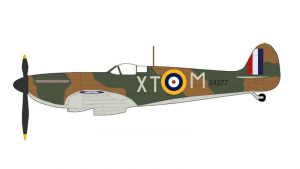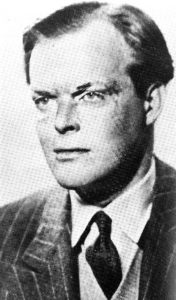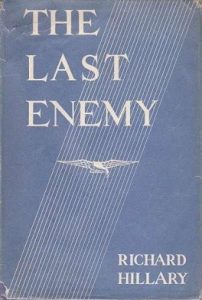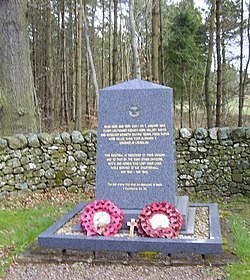Richard Hillary – Spitfire Pilot

On 3 September 1940, one of the handsomest young pilots in the RAF had flown with his squadron out of Hornchurch, on the Thames Estuary, near London. Richard Hillary wearing neither gloves nor goggles – preferring to feel unencumbered – was, with his companions, defending Britain and seeking to add to his enemy ‘kills’. On that particular day he had the opportunity to hit and damage a Messerschmitt 109. Giving chase, rather than curving away, he fell foul of another enemy aircraft, which opened fire with both cannon and machine guns, causing his Spitfire to burst into flames. He just managed to slide his cockpit canopy open before losing consciousness. The burning aircraft then rolled over on its back, tipping him out into the void over the English Channel. Regaining consciousness just in time to pull the ripcord of his parachute, he slowly followed his burning machine as, seconds later, it dived into that precious strip of water and disappeared from view.
Richard was rescued by the crew of a Margate lifeboat which had been watching the dogfight from the shore and spotted the descending parachute, but had trouble locating the injured pilot. When they did so, Richard’s stunning good looks were no more. Terribly burned on the face, hands and legs, blinded by swollen flesh around his eyes, he was lucky to be alive. But coming back to something approaching real life would be a marathon in itself. When he was shot down he had just seven days combat experience behind him, during which he had accounted for at least five enemy aircraft. He was not resentful. Professing himself to be unpatriotic and believing that the reason for fighting in a war was a means to, ‘swiftly develop all one’s faculties to a degree it would normally take half a lifetime to achieve’. He never ceased to believe that ‘in a fighter plane, we have found a way to return to war as it ought to be, war which is individual combat between two people, in which one either kills or is killed’.
In addition to still being alive, Richard had another stroke of luck: the pioneer of reconstructive surgery, the New Zealander Archibald McIndoe, had established a burns unit at the Victoria Cottage Hospital at East Grinstead in Sussex. McIndoe’s intricate and experimental operations on the desperately badly burned – his ‘guinea-pigs’ – would later earn him a knighthood and a place in medical history. But initially, after being transferred from Margate, Richard had begun treatment for his injuries at the Royal Masonic Hospital at Ravenscourt Park in London, which used the excruciatingly painful wax-sealing method to treat burns. It was from here that McIndoe collected him and took him south to Sussex, where he had developed his own methods of care.
Educated at Shrewsbury and at Trinity College, Oxford, Richard was born in Sydney to Australian parents. He was an only child. Plump and round-faced as a schoolboy, as he grew older he became increasingly attractive, with his straight nose, well-shaped mouth and ‘blazing blue eyes’. Athletic, a gifted oarsman who stroked the champion Trinity College boat two years in succession, he was a linguist and read widely. He also had a complex, existential side to his character, which caused him a good deal of defiant soul-searching.
It was Richard’s hands which had suffered most in the accident. They were so badly damaged as to become claw-like and would never totally recover. His legs would eventually heal, but it was the injuries to his face that were initially the most distressing. The eyebrows and lashes had been burnt off. The flesh of the lower forehead, the bridge of the nose and the top lip were also all badly burned. To Dr McIndoe came the task of working on a man whose looks and confidence had been striking, enabling him to attract virtually any woman who pleased him – and he was rarely without one by his side. Now he would have to come to terms not only with his changed looks, but also with what to do with the rest of his life. Dr McIndoe’s reply to Richard’s question as to when he might fly again was ‘The next war for you’, made in decided tones.

In the early months of 1941, the long and painful skin grafting began. Here Richard fought off depression, recurring infection and intense pain, and established himself as the arrogant enfant terrible of the ward – admired by some, disliked by others. In spite of the raw and patchworked look of his face and the claw-like hands, he did not lose his allure. In David Ross’s biography of Hillary, there is an account of a fellow patient at East Grinstead remembering: ‘He always seemed to have several beautiful girls on the go at the same time! There were a number of times when we saw a pretty girl rush from the ward, handkerchief clutched to her mouth, crying her eyes out because Richard had jilted her. We were very envious of him.’ His fine physique, edgy but intense charm and the remains of his good looks ensured that, for the remaining years of his life, lovely women would continue to float around him like dipping swans.
In between operations, he was sent to recuperate in a luxurious convalescent home for officers, Dutton Homestall, in nearby Ashurst Wood. The house was the home of ‘Johnny’ Dewar (of the whisky company of that name), his wife Kathleen, and daughter, Barbara. The family, like so many others, had condensed themselves into the lodge and given the main house over to the Red Cross. It was no time before Barbara Dewar and Richard had formed the sort of relationship that prompted Barbara to give him a photograph of herself in a ballgown inscribed: ‘To my darling Richard, with all my love, Barbara’. The flirtation was short-lived and ended amicably, although the episode caused Barbara’s mother intense irritation. It was felt by some that Kathleen Dewar was herself attracted to Richard, and that this unreciprocated feeling turned into unfriendly aggression. In later months a fearsome quarrel erupted between them, in front of other convalescents, in which Kathleen accused Richard of taking advantage of his injuries and hiding behind them in order not to have to return to flying. In her fury she called him a coward – an accusation never to be forgotten.
At that stage Richard’s grafts were still very white and incomplete and one arm was supported on ‘a kind of tennis-racket contrivance with loops on the rounded frame to straighten crooked fingers’. He was contemplating writing an account of his experiences but uncertain how to begin, when a friend introduced him to a ‘real writer’ who might be able to encourage him. This was Winifred Fortescue, a best selling author of her day, whose autobiography Perfume from Provence had, followed by five other books on her life in the South of France, made her famous. At this time Winifred, having fled France in 1940, was lecturing far and wide in England in order to raise funds for the Free French and living in a simple woodsman’s cottage in a valley on an estate near the village of Ardingly. She called it Many Waters. Richard was enchanted with the setting of the cottage and it was here he first spoke of the Circles of Peace. Winifred recorded his words: ‘For years I have been looking for the Circles of Peace. This is the centre of the Circles of Peace.’

So began a pleasant friendship during which Richard often visited Winifred in her cottage and, encouraged by her, began the draft of what would become his famous book The Last Enemy. Until one day she was summoned to the telephone in one of the gardener’s lodges at the top of the hill to be greeted by Richard’s joyous message ‘I’ve got a job! I’ve got a JOB,’ and asking if he might come to tea that afternoon to tell her all. Thrilled with his news, Winifred descended her hillside and waited – and waited. She never saw him again.
Richard was sent to the United States by the British government with the intention of giving lectures throughout the country on the state of the war in Europe. It was his own idea, basically approved of by Archibald McIndoe, that he should contribute to the efforts being made to encourage America to join the Allies. However, McIndoe was concerned that the work on Richard’s face was unfinished and he would have liked to have completed it before it was displayed before his medical colleagues in the United States.
Initially all went well, until the moment the British Ambassador met Richard in Washington and felt immediately that the reaction of American mothers might be one of horror that their sons could become so disfigured in combat, thus producing the opposite effect to that desired. Consequently, the decision was made to restrict him to reading his speeches over the airwaves and writing articles and pamphlets on the British cause. This was a great blow. Not only had his plans been dashed, but the verdict that he was too damaged for general view could only have been humiliating. What he had tried to rise above in England had been brought home to him only too brutally in the United States. But staying in New York with the rich and kindly Edward and Mary Warburg, Richard was provided with the sort of comfort, friendship and admiration that helped to ease his disappointment. Mary was possessive of him and made sure he accompanied them to parties and the theatre and was included in the social life of the city. And here at last he could begin to write properly, as Peggy had urged him to. Writing was difficult. His damaged and crooked fingers could hardly hold a pen or pencil and he found a Dictaphone difficult to deal with, but Edward Warburg encouraged him, providing a room in which to work and introducing him to the publishing world.
The finished book, called in the United States Falling Through Space, was published there in February 1942. The speed with which the book was written during Richard’s busy stay in America, which included another operation on his face (disapproved of by Dr McIndoe), prompted suspicion that he had professional help. Even if this was the case, no one but Richard could have produced the basic material, and his character, described in detail by so many people, comes through on every page.
In spite of his injuries having been brought so much to the fore by the controversy over his appearance, lovely women clustered around Richard in the salons of New York and Washington as they had in London and Sussex. One in particular met and quickly won him – the actress Merle Oberon, who had married Alexander Korda in Cannes in the summer of 1939. Their affair was entirely satisfactory to them both, and came at exactly the right time for Richard. To possess such an internationally acclaimed beauty must have been balm to his injured pride and, when he left for England in the autumn and the affair came to an end, their affection for each other endured. Merle did something else for Richard, she gave him the address of her good friend Mary Booker. An admired beauty and part of the London social scene, Mary was divorced, mother to two girls, and forty-four to Richard’s twenty-two years. Her calmness and maturity attracted him immediately, resulting in an affair of passion combined with a sort of convoluted intellectual torture.
But Richard missed the camaraderie of the pilots’ mess and the concept of ‘kill or be killed’. Although almost all his close friends had indeed been killed in action, he longed to be part of all that once more. In April 1942 he went back to East Grinstead and Dr McIndoe to have more operations, which included work to try to straighten out two of his fingers, with the goal of being passed for operational flying once more. McIndoe hated to see his pilots, who had been through so much, go back on active duty: ‘You’ve done your stuff, and now the other silly sods can get on with it.’ This did nothing to deter Richard. During the course of the year, further operations, examinations by medical boards, refusals and yet more operations followed one another monotonously.
The planned British publication of Falling Through Space was a high point. But this was not a title Richard liked. Published in June 1942, it was renamed The Last Enemy, a phrase from the Bible –‘the last enemy that shall be destroyed is death’. In those days of paper shortage 15,000 copies were printed initially. They were sold out within a few weeks and after that it was impossible to keep up with the demand. Interviews and publicity filled the summer months and increased the hope of Richard’s friends that he would now discard the idea of flying and take up writing as a career. But, ever obstinate, he had not given up. Working at an RAF desk job, he continued to attend medical boards to try to get himself passed as fit to fly. Relentlessly persuading and insisting, in November 1942, by sheer force of character and against the explicit wish of McIndoe, he got himself accepted for night-flying training on bombers. Significantly, Richard had admitted he was more afraid of what people would say if he did not return to flying than what would happen if he did. It seems as if Kathleen Dewar’s taunting words still rang in his ears.
Winifred Fortescue had often thought of Richard since he had visited Many Waters, her woodsman’s cottage in Ardingly, and the news of the success of The Last Enemy filled her with joy and pride: ‘I awaited his letter telling me of his achievement – or perhaps he would just send me a copy of THE book which we had so often discussed. I waited in vain, but though human enough to be disappointed, nevertheless I knew that in spite of the disparity of age, nothing could change the friendship between us.’

Having at last got his way, Richard was posted to the bleak RAF Charterhall airbase in Scotland and, on a freezing night in early January, accompanied by his radio operator Kenneth Fison, the father of two children, he set off in his twin-engine Bristol Blenheim for the second flight exercise of the night. Below him, in an office near the airfield, a letter from Archibald McIndoe, expressing his opinion that Richard was not ready to resume flying and should return to Sussex, had only just been opened by the squadron’s doctor. It had lain in a drawer for two weeks while he was on leave.
The night-flying exercise involved Richard and Kenneth Fison tracking a fellow pilot on radar – an operation in which the two pilots took turns. While waiting for the other aircraft to become airborne, Richard began to fly in great circles around a beacon. The summing-up by those present at the time was that, part of the way through the circuit, the control surfaces began to ice up and Richard, struggling with his crooked hands, lost control of the plane. In a matter of seconds, the aircraft ploughed into the ground and exploded, killing both him and his radio operator. Richard was twenty-three.
Winifred, now far from Sussex, heard of his death while she was ‘watching the hawks wheeling and swooping suddenly from the sky’ above a high tor in North Devon. Filled with emotion, she quoted, on his behalf, the seventeenth-century poet Henry Vaughan’s lines: ‘I saw eternity the other night like a great ring of pure and endless light.’
Taken from Escape to Provence by Maureen Emerson
© Copyright: Maureen Emerson 2019
Sources:
- Trampled Lillies. Winifred Fortescue
- The Last Enemy. Richard Hillary
- Mary and Richard. Michael Burn
Links:
